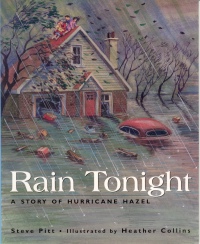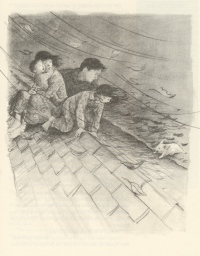| ________________
CM . . .
. Volume XI Number 11 . . . .February 4, 2005
excerpt: It seemed as if she had just closed her eyes when Penny was wakened by a terrible noise. Her parents were shouting in a way she had never heard before, and somewhere her little brother was crying hard. As soon as Penny put her feet down on the floor, she knew what was wrong. There was water up to her ankles! It was very dark in her bedroom, but suddenly the lights came on. Penny and Mrs. Hargreaves were shocked to see that their bed had become a small island sitting in a lake of muddy water. They got up and found Penny's family in the living room. The water appeared to be rising. "What will happen if it reaches the electrical outlets?" Penny's mother asked, as she tried to soothe little Tommy, whom she held tightly in her arms. Tom shot a look in Penny's direction, not wanting to answer in case he frightened his daughter further. But Penny heard the urgency in his voice as he said, "Follow me. We have to get out - now!" Rain Tonight recounts the evening of October 15, 1954, when more than eighty-one people in the Toronto area lost their lives to Hurricane Hazel. Author Steve Pitt uses personal journals, newspaper stories, and interviews to recreate the event as it unfolded for Penny Doucette and her family, residents of Weston, Ontario, a small community along the banks of the Humber River. Like so many of us untouched by natural disaster, Penny and her classroom studied Hurricane Hazel and the damage she imposed on the Caribbean and Eastern seaboard at a safe distance, never thinking she would have a devastating impact on their own lives.
While there's lots of technical information in the first chapter, the second offers a quickly engaging description of the impact of the impending crisis on the residents of Weston, and Penny's recognition that this was no ordinary storm. Reports of stranded motorists are quickly eclipsed by visits from worried neighbours and growing water levels that force the Doucettes to escape to the roof by hacking a hole in the attic ceiling. Penny's experience on the roof, watching neighbours struggle to survive and her world wash away, is completely involving. Her helplessness in saving a pig which attempts to clamber on to their refuge is a poignant lesson that there is loss in times of crisis. The family and their neighbour are eventually rescued by the heroic efforts of two men in a motor boat, and their perilous adventure in getting everyone back to shore concludes the story on a high, dramatic note. Pitt recounts the details of the storm as a story with technical information included in the main text but mostly isolated to the margins and identified by a blue background. Black and white illustrations by Heather Collins, whose work with Barbara Greenwood in a similar format will be familiar to many, adds greatly to the story and its feel of accessibility to young readers. More information about the people introduced in the story is included in an epilogue, along with photos of the people and places described in the story. As a text that could enhance a classroom discussion of weather, the inclusion of a map tracking Hazel's progress, and websites and other resources on weather would have also been useful. This book offers good information on hurricanes, a real life drama that young readers will enjoy and learn from, and characters with whom readers can identify and empathize. The narrative format, however, which involves recreating dialogue and thoughts attributed to real people, poses some risk. While the author gives the reader his commitment to accurately capturing the characters and events, the format lends itself to assumptions and creative license that many (including jury members of the Orbis Pictus award for nonfiction in the US) argue can compromise the truth. A format that acknowledges that history is as much about what we don't know (or remember), as what we do, makes reminders that "This is a true story," unnecessary. Recommended. Lori Walker is completing a Masters in Children's Literature at UBC.
To comment
on this title or this review, send mail to cm@umanitoba.ca.
Copyright © the Manitoba Library Association. Reproduction for personal
use is permitted only if this copyright notice is maintained. Any
other reproduction is prohibited without permission.
NEXT REVIEW |
TABLE OF CONTENTS FOR THIS ISSUE
- February 4, 2005.
AUTHORS |
TITLES |
MEDIA REVIEWS |
PROFILES |
BACK ISSUES |
SEARCH |
CMARCHIVE |
HOME |

 In the first chapter, Pitt sets the stage. Penny and her fellow grade two students are introduced to
how Hurricane Hazel came to be. It was an unusually long, hot summer along the coast of West
Africa, and the subsequent heating up of the Atlantic Ocean of the African Coast resulted in a
layer of water vapor that developed into low-lying cloud. When the cloud was spun with the
earth's rotation, momentum was established, and, in the case of Hurricane Hazel, a wind speed of
74 miles per hour (118.4 km per hour) resulted. When Hazel failed to die away after hitting Haiti
and traveled up the eastern seaboard, few were concerned that the storm would be felt in Ontario.
In fact, the weather forecast was "Rain tonight," nothing more. But Hazel was forced north by the
earth's rotation and into low-lying coast land towards Weston and the Doucette family.
In the first chapter, Pitt sets the stage. Penny and her fellow grade two students are introduced to
how Hurricane Hazel came to be. It was an unusually long, hot summer along the coast of West
Africa, and the subsequent heating up of the Atlantic Ocean of the African Coast resulted in a
layer of water vapor that developed into low-lying cloud. When the cloud was spun with the
earth's rotation, momentum was established, and, in the case of Hurricane Hazel, a wind speed of
74 miles per hour (118.4 km per hour) resulted. When Hazel failed to die away after hitting Haiti
and traveled up the eastern seaboard, few were concerned that the storm would be felt in Ontario.
In fact, the weather forecast was "Rain tonight," nothing more. But Hazel was forced north by the
earth's rotation and into low-lying coast land towards Weston and the Doucette family.